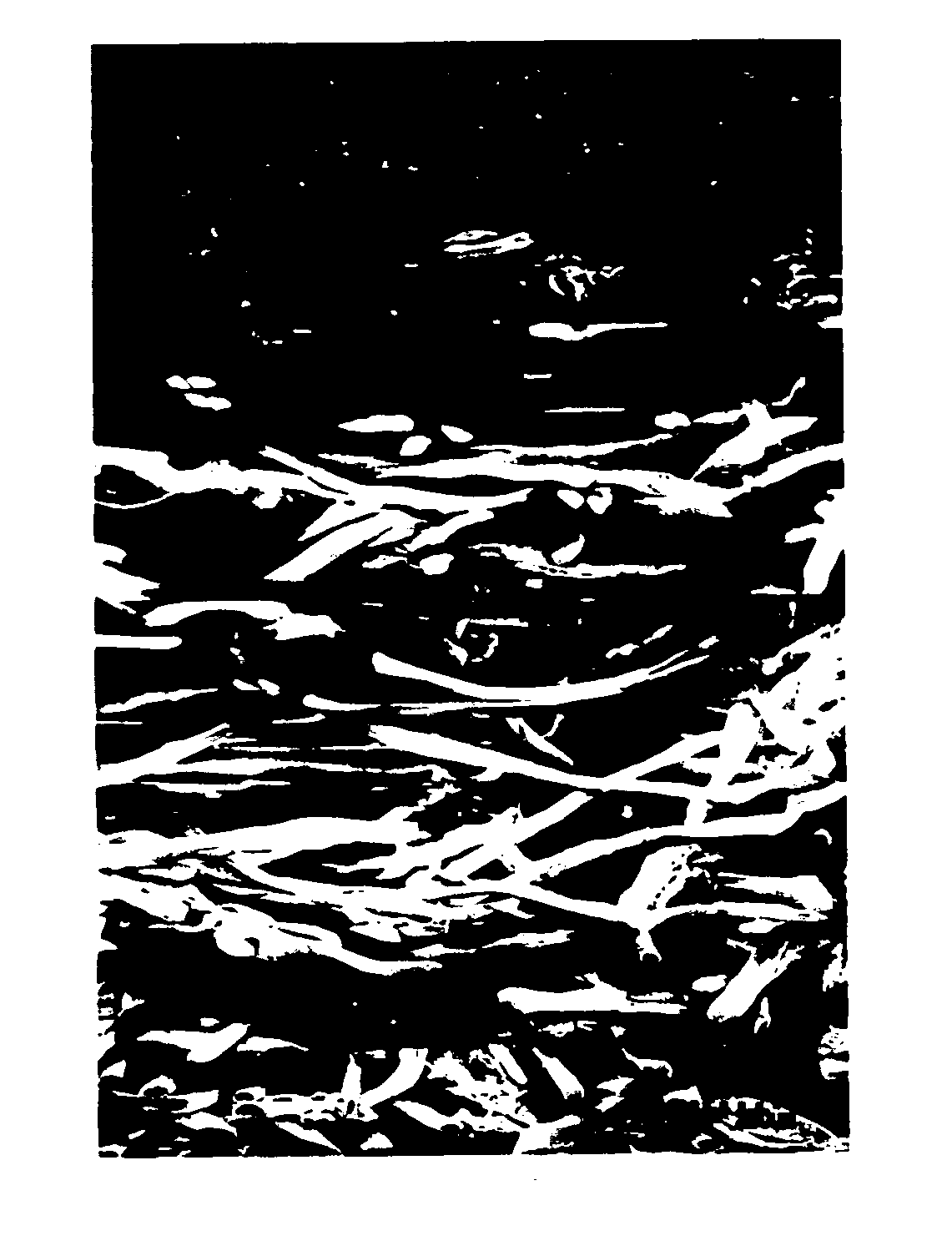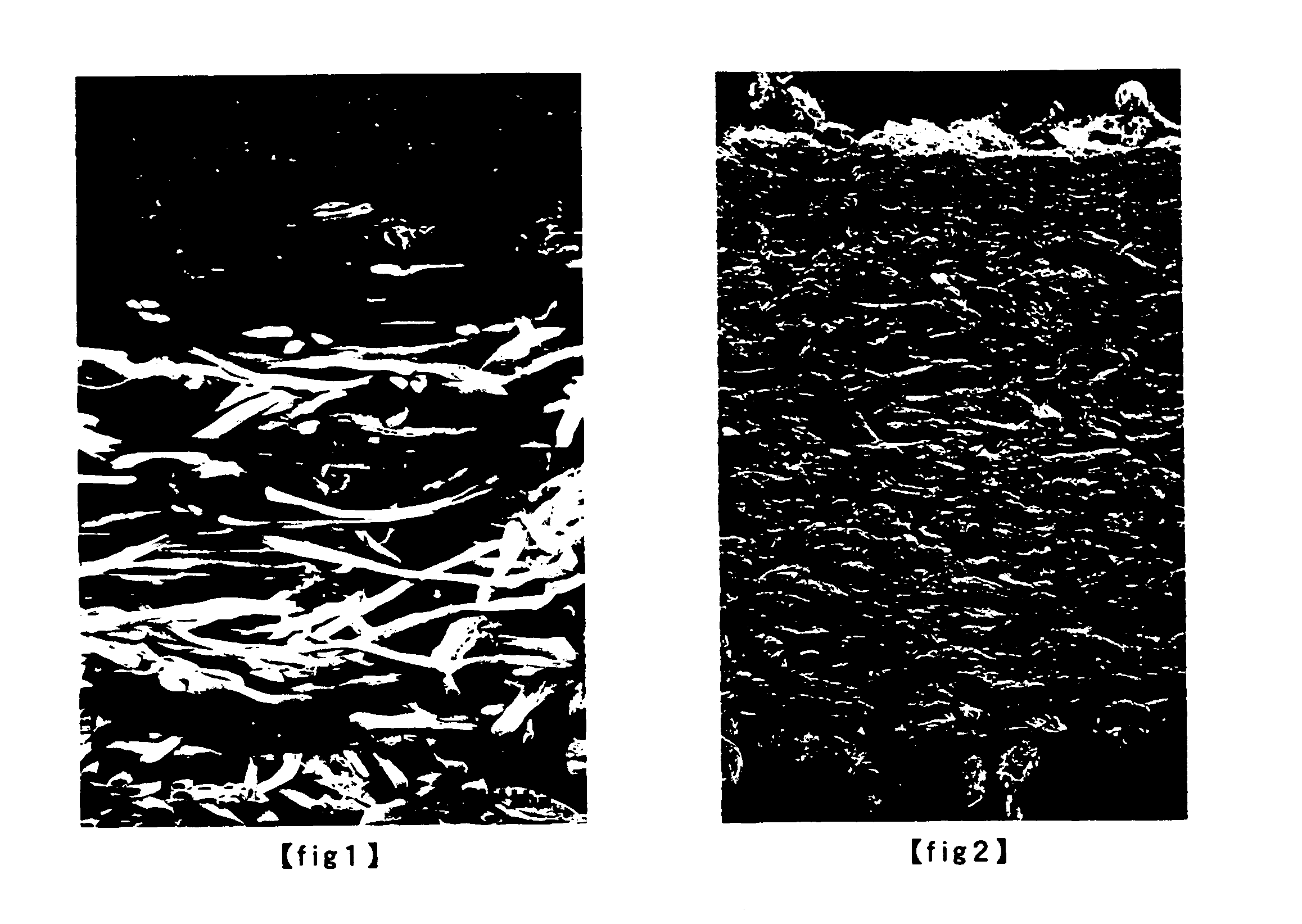Artificial leather sheets and method for producing them
a technology of artificial leather and raw materials, applied in the field of artificial leather sheets, can solve the problems of rough appearance, immeasurable suffering of artificial leather made of elastic fibers and inelastic fibers, and low compatibility or affinity of artificial leather, and achieves the effects of low melt viscosity or surface tension, reduced friction, and improved elasticity
- Summary
- Abstract
- Description
- Claims
- Application Information
AI Technical Summary
Benefits of technology
Problems solved by technology
Method used
Image
Examples
example 1 (
E-1)
[0076]Poly-3-methyl-1,5-pentane adipate glycol having a mean molecular weight of 2000, 4,4′-diphenylmethane diisocyanate, polyethylene glycol and 1,4-butanediol were melt-polymerized so that the nitrogen content attributable to the isocyanate group was about 4.3% to produce a polyester polyurethane having a melt viscosity of about 5000 poises. In a screw extruder, 50 parts of the polyester polyurethane pellets, having been dried to a water content of at most about 50 ppm (island elastic polymer), and 50 parts of low-density polyethylene pellets (sea component) were melt-kneaded, and then melt-spun out at 230° C. to give sea-island mix-spun fibers (A0) having a fineness of 14 dtex and having polyurethane partly exposed to the surface thereof. Separately, 50 parts of nylon-6 pellets (island inelastic polymer) and 50 parts of polyethylene pellets (sea component) were melt-kneaded in a screw extruder and then melt-spun out at 280° C. to give sea-island mix-spun fibers (B0) having a ...
example 2 (
E-2)
[0083]A 20% solution of polycarbonate polyurethane in DMF solvent was applied to both surfaces of the entangled nonwoven fabric (III) fabricated in Example 1, in an amount of 500 g / m2 on each surface by the use of a roll coater to form a grain layer thereon, then put into an aqueous 30% solution of DMF at 40° C., and washed with water to thereby replace DMF remaining in the entangled nonwoven fabric with water. This was processed in a hot toluene bath at 90° C. to dissolve and remove polyethylene from the fibers (A1) and the fibers (B1), then processed in hot water at 90 to 100° C. to thereby substitute toluene existing in the entangled nonwoven fabric with water through azeotropy with water, and dried while set in a predetermined width to give a grained artificial leather sheet having a thickness of about 1.3 mm.
[0084]In the grained artificial leather sheet thus obtained, the mean fiber diameter of microfine fibers of nylon was about 1.1 μm. Electron-microscopic observation of ...
example 3 (
E-3)
[0085]An embossed release paper (Lintec's TP R-8) was coated with a polyurethane resin solution comprising 100 parts of silicone-modified polyether polyurethane (Dainippon Ink Chemical Industry's NY214, 100%-modulus 40%, solid content 20%), 20 parts of black pigment (Dainippon Ink Chemical Industry's Dailac L6910N), 30 parts of DMF and 30 parts of methyl ethyl ketone to form a coating layer thereon, so that the mean thickness of the dried layer was about 40 microns, and then heated at 100° C. for 5 minutes to form thereon the intended coating layer. This was further coated with a two-pack curable polyether polyurethane solution so that the mean thickness of the dried adhesive layer was about 30 microns, and dried at 50° C. for 3 minutes. On the other hand, the artificial leather sheet (I) fabricated in Example 1 was sliced, into two parts, at the center in the direction of the thickness, and the sliced face was polished by the use of a buffing machine with #180-grit sandpaper, a...
PUM
| Property | Measurement | Unit |
|---|---|---|
| diameter | aaaaa | aaaaa |
| diameter | aaaaa | aaaaa |
| thickness | aaaaa | aaaaa |
Abstract
Description
Claims
Application Information
 Login to View More
Login to View More - R&D
- Intellectual Property
- Life Sciences
- Materials
- Tech Scout
- Unparalleled Data Quality
- Higher Quality Content
- 60% Fewer Hallucinations
Browse by: Latest US Patents, China's latest patents, Technical Efficacy Thesaurus, Application Domain, Technology Topic, Popular Technical Reports.
© 2025 PatSnap. All rights reserved.Legal|Privacy policy|Modern Slavery Act Transparency Statement|Sitemap|About US| Contact US: help@patsnap.com


